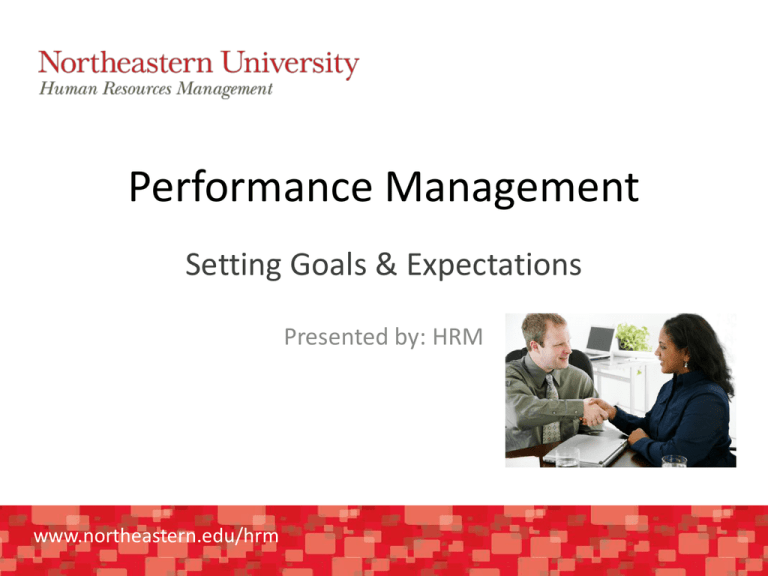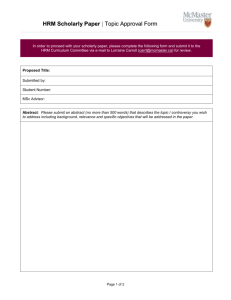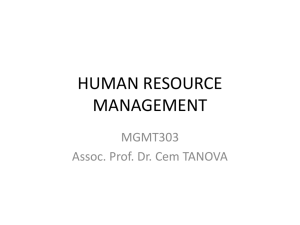Setting Goals and Expectations
advertisement

Performance Management Setting Goals & Expectations Presented by: HRM www.northeastern.edu/hrm Agenda Key Points Practice Setting Goals Performance Cycle • Alignment • SMART • Draft & Align • Metrics 2 The Performance Management Cycle I. Performance Planning/ Expectation Setting III. End of Year Evaluation Goal Setting Clarify expectations Establish annual goals Link to college/ division goals Plan professional development II. Ongoing Review and Feedback 3 Goals & Setting Expectations Scenarios 4 It’s all about alignment • Drivers that impact performance – – – • Understanding of performance standards Understanding how the systems work Accountability for “things that matter” Linking individual work to “things that matter” – – – – Know what organizational issues influence work Know how the unit contributes to the University Know how the team contributes Know how the individual contributes Corporate Leadership Council – Building High-Performance Workforce: Chapter Two-Seven Keys to High Performance Corporate Leadership Council - Driving employee performance and retention through engagement 5 Key Tips on Writing Goals • Focus on the individual’s work to ensure their actions are directed at achieving results critical to the organization's success • Connect the individual’s work to the goals of the department, division and Northeastern overall • Do not encapsulate the entire job, only the key goals, projects, and accountabilities. Set one professional development goal each year. • Typically goals start with a verb and focus on the end results SMART Goals S • Specific M • Measurable A • Achievable R • Results Focused T • Time Focused • Goals should be SMART 6 Key Points about Performance Setting Expectations • Be clear & specific • Review job responsibilities • Discuss “fully meets” • Create a plan • Check in regularly • Ask for input Being Consistent • Provide frequent feedback • Review goals regularly • Discuss expectations • Assess results • Foster open environment • Gather feedback, too – don’t just give it 7 8 Creating a Development Goal Step Action 1 Define the development need. Define in behavioral detail. Ask yourself what is the evidence that this is a development need? What are the consequences if I don’t address this? What are the root skills? 2 Create a timeline. Include due dates. Deadlines anchor your intentions to daily activities. Include action/by when/resources. Add measures. When development occurs, how will you know it? How will you measure your progress? Add “backstage” actions. How do I find out more about ___? Locate a course, attend it, and extract learning from it to put in your development plan. Read a book or talk to a subject matter expert. Add “onstage” actions. These are the things you do on the job. Things you will do DIFFERENTLY. 3 4 5 9 Improving Goals: Why SMART? GOAL: S M A R T I want to lose weight I want to lose 20 lbs. by April. I will perform a half hour of cardio and half hour of strength training per day, 5 times a week and I will only eat starchy carbohydrates 3 times a week. 10 Summary Points Goals & How to get there • Be sure to spend focused time with all of your direct reports to determine their key goals for the year, to determine their unit, division or department, and organization-wide impact and to discuss their development goals, including learning action plans and measurements for success. Development • Spending time discussing and documenting your direct report’s development needs can be both a short- and long-term benefit to you in terms of motivation and growth. Feedback, feedback, feedback • For development to occur, individuals have to • DO something NEW, • DO something DIFFERENTLY than before, or • STOP doing something currently being done. 11 TOOLS & RESOURCES Key Questions about Development Below are several suggested questions to ask to get you started in conducting a development conversation with your direct report. • Where should he/she be a year from now in terms of job satisfaction, skill development, accomplishments, and readiness for other jobs? • Have changes recently occurred in your unit -- how will they affect him/ her? • Is development needed to create challenge and personal growth or as a solution to a performance problem? • Is development needed to prepare for new responsibilities? • What strengths does the individual demonstrate that you want to leverage? • Which skills, if improved, would impact performance the most? • Does your direct report have an up-to-date development plan? 13 Resources • lynda.com – accessed through myNEU – Managing Your Team • Section One: Motivating Your Team: 7 minutes – Mastering the goal setting process – Elements of effective goals – Leading Productive One on One Meetings • Section Two: Setting up a One on One: 2 ½ minutes – Determining the agenda • HRM – For Managers – Performance Mgt.– copies of previous presentations, forms, tips – Discussion & Practice - we’re here to assist you with this! • Reach out to your HRM Consultant or Training & Development with questions or to practice.











